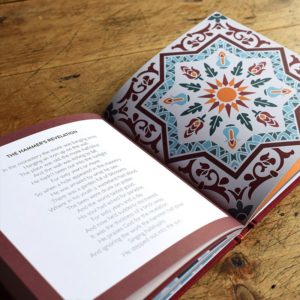
Brian Patten, author of the beautiful The Book Of Upside Down Thinking, joins us once again as a guest on the blog to give us a further insight into his magical new collection of humorous and thought-provoking verse, in this post looking at interpreting the stories.
There is no one interpretation or ‘meaning’ to a Djuha story and there are hundreds of stories. The first ones I read were in an old travel book I picked up in a second-hand comic exchange when I was fourteen, in Liverpool. The latest story was told me a few weeks ago in Hammersmith, London, by Martin, my Turkish barber. His mum told him the story when he was little. Fortunately, Martin put his scissors down while telling it as he was laughing so much. According to the Sufi teachers who used the stories, an accumulation of them will gradually seep into the consciousness and subtly transform the reader or listener’s perception of the world. (I think Martin’s perception of the world is fine as it is, and I seriously hope he doesn’t go wandering off with his scissors to become a guru.)
One of the most famous of all the stories is the one where someone is searching for something they have lost, in a place where they never lost it. Here’s a version of it from the new book. See what you make of it.
SEEING THE LIGHT
He lost a ring down an alleyway.
He saw no point looking for it there.
The night was black, the alley dark,
He wandered off to look elsewhere.
I saw him under a street lamp
Later on that night.
“Why are you looking here?” I asked.
He said, “Because there is more light.”
You might think the verse is simply about the absurdity of looking for what you want in a place you know you never lost it, and that’s fine. But another interpretation might be that by looking for something only in what seems an obvious place, you’re limiting your options of finding it, no matter what it is- a lost key, a ring, love, or enlightenment. Yet another interpretation might be that the “seeker” is looking where it’s easiest to look, rather than in more difficult or obscure places, where what he’s seeking is more likely to be found. Someone else might say that that person will not find what he is looking for no matter where he looks, if he is not ready to find it.
Brian Patten, author of the beautiful The Book Of Upside Down Thinking, joins us once again as a guest on the blog to give us a further insight into his magical new collection of humorous and thought-provoking verse, in this post looking at interpreting the stories. There is no one interpretation or ‘meaning’ to a Djuha story and there are […]

Acclaimed poet Brian Patten, author of the beautiful The Book Of Upside Down Thinking, joins us as a guest on the blog to give us an insight into the inspiration behind this magical new collection of humorous and thought-provoking verse. Written in Morocco The Book of Upside Down Thinking was inspired by folk-stories from the Near and Middle East that date back as far as the 11th century...read on to find out more from Brian.
Most of the short poems in The Book of Upside Down Thinking are based on stories that are usually attributed to a character in folklore, a trickster and wise fool much loved throughout the Near and Middle East. A transliteration across different alphabets results in different or inconsistent spellings of his name. In Turkey he travels under the name of Nazrudin or simply Hodja; in Libya and Morocco he’s Si’ Djeha, in Palestine and Iraq he’s known as Bahlul. In Sicilly he’s Giufa. He has other names, and the multitude of stories attached to him are either humorous or contain a wonderful surreal logic.
Records of Djeha stories stretch back over a thousand years. One of the earliest mentions of the character’s escapades was in a manuscript/book called the Eccentricities of Djuha that was referenced at the end of the tenth century. A version of some of his antics crops up in Fabulae Centum, a collection of fables published by Garriele Faerno in 1564. In 1888 one of the first modern collections was published in Cairo. In the early part of the 20th Century a dozen or more Khoja Nasr ed-Din stories appeared in a travel book called An Eastern Chequerboard by Sir Harry Luke, a little remembered but fascinating travel writer and diplomat. Comics bearing Nasrudins’s name can still be found in most Turkish market-places today. In other words, if you look for him he’s everywhere you look.
The stories were often used as teaching stories. An authority on Sufi literature, Idries Shah, published numerous books of his tales, and as he explained in his book The Sufis, “It is inherent in the Nazrudin story that it may be understood at any one of many depths.” They can be taken as stories and jokes, but they also help show the world from a different and unexpected perspective. Their aim was to rattle the cage of conventional thinking. Like some of Aesop’s animal tricksters, they’ve travelled through time unscathed because they address the eternal conflicts, hopes and follies of human kind.
Various sources have Nazrudin born in Turkey in 1208, where each July a festival is held in his honour and where one can find his grave. The Moroccans, for whom he’s Si’ Djeha el Fasi, claim he was born in Fez, where a street is named after him. In truth, no one really knows where or when he was born, or even if he existed at all. The debate has been going on for centuries. Adapted into rhymes, The Book of Upside Down Thinking contains some of my favourite stories. Occasionally I’ve used them as jumping–off places and given them a different, more Western twist (A Test of Faith and The Hammer’s Revelation being two). Others are originals, but could not have existed without Nazrudin’s inspiration.
Brian Patten
Read a selection of verses from The Book Of Upside Down Thinking & order your copy here.
Acclaimed poet Brian Patten, author of the beautiful The Book Of Upside Down Thinking, joins us as a guest on the blog to give us an insight into the inspiration behind this magical new collection of humorous and thought-provoking verse. Written in Morocco The Book of Upside Down Thinking was inspired by folk-stories from the […]